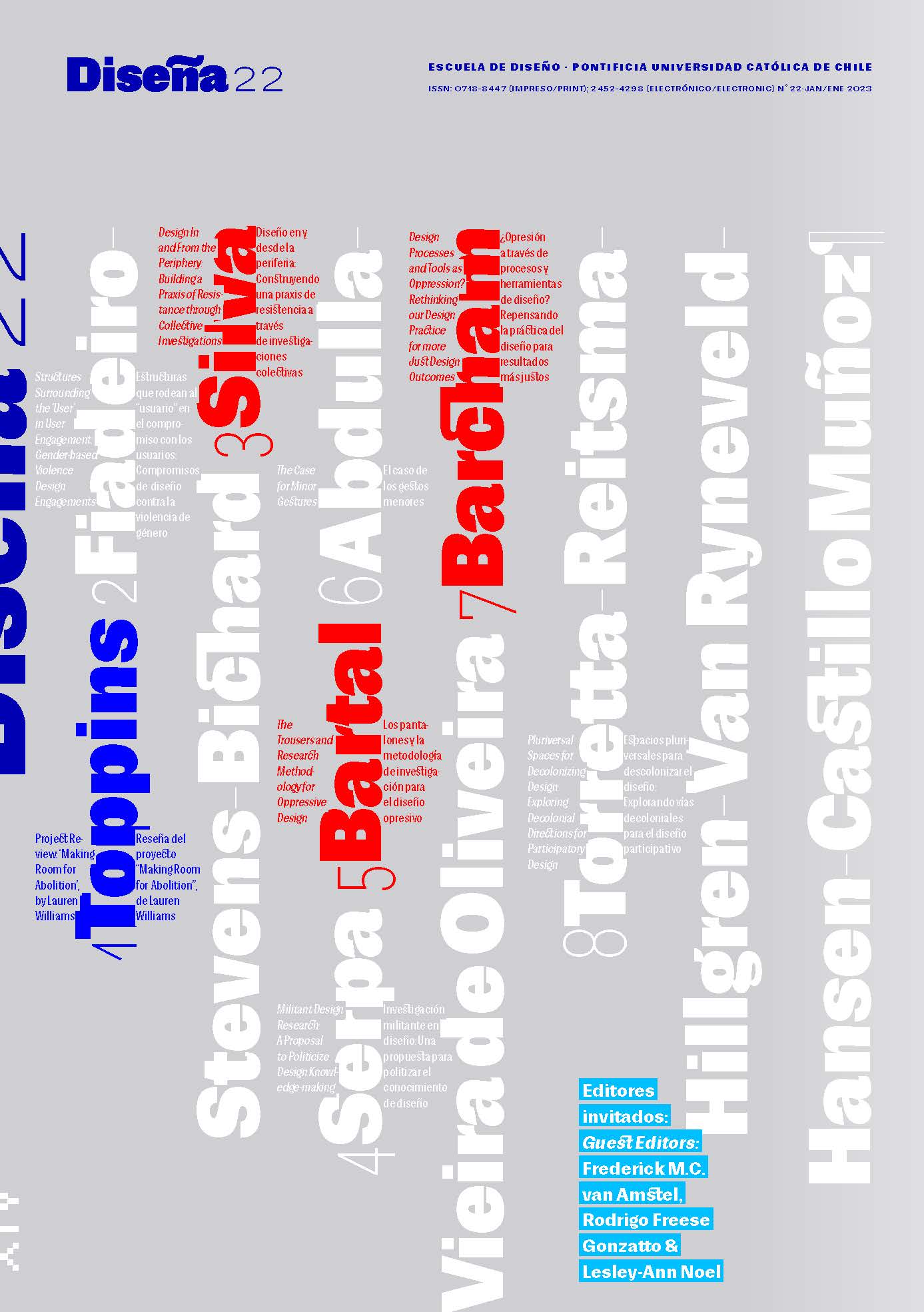Project Review: ‘Making Room for Abolition’, by Lauren Williams
Main Article Content
Abstract
This review positions Lauren Williams’ installation ‘Making Room for Abolition’, shown in ‘Monolith’ at Red Bull Arts in Detroit, as a speculative design project that presents a two-fold critique: one directed at US society and the other, at speculative design itself. As a discourse and practice, speculative design offers a model for designing in socially-oriented, post-capitalist contexts, but it has yet to fully unmoor itself from colonialist ideology. I present common critiques of speculative design—specifically: the lack of attention to race- and class-based struggles, the assumption that time is absolute, and its stance that preferable futures must be plausible—to show how Williams addresses these shortcomings while centering Black experiences and imagination in a dream of abolitionist futures.
Downloads
Article Details

This work is licensed under a Creative Commons Attribution-ShareAlike 4.0 International License.

This work is licensed under a Creative Commons Attribution-ShareAlike 4.0 International license.
COPYRIGHT NOTICE
All contents of this electronic edition are distributed under the Creative Commons license of "Attribution-ShareAlike 4.0 Internacional" (CC-BY-SA). Any total or partial reproduction of the material must mention its origin.
The rights of the published images belong to their authors, who grant to Diseña the license for its use. The management of the permits and the authorization of the publication of the images (or of any material) that contains copyright and its consequent rights of reproduction in this publication is the sole responsibility of the authors of the articles.
References
Álvarez Caselli, P., Palmarola, H., & Cristi, N. (2021). History of Design, Techniques, and Technology. Diseña, (18), Intro. https://doi.org/10.7764/disena.18.Intro
Asher, J., & Horwitz, B. (2020, June 19). How Do the Police Actually Spend Their Time? The New York Times. https://www.nytimes.com/2020/06/19/upshot/unrest-police-time-violent-crime.html
Auger, J. (2013). Speculative Design: Crafting the Speculation. Digital Creativity, 24(1), 11–35. https://doi.org/10.1080/14626268.2013.767276
Benjamin, R. (2019). Race After Technology: Abolitionist Tools for the New Jim Code (1st ed.). Polity.
Brooks, L. A. (2022). From Algorithms to Afro-rithms in Afrofuturism. In A. H. Berry, K. Collie, P. A. Laker, L.-A. Noel, J. Rittner, & K. Walters (Eds.), The Black Experience in Design: Identity, Expression & Reflection (pp. 324–340). Allworth.
Castrodale, J. (2021, May 19). Here’s what that Flamin’ Hot Cheetos Controversy Is All About. Vice. https://www.vice.com/en/article/akgv55/heres-what-that-flamin-hot-cheetos-controversy-is-all-about
Chakrabarty, D. (2000). Provincializing Europe: Postcolonial Thought and Historical Difference. Princeton University Press.
Davis, A. Y. (2003). Are Prisons Obsolete? Seven Stories Press.
Dunne, A., & Raby, F. (2013). Speculative Everything: Design, Fiction, and Social Dreaming. MIT Press.
Fair, H., & Walmsley, R. (2000). World Prison Population List, Thirteenth Edition. Institute for Crime & Justice Policy Research. https://www.prisonstudies.org/sites/default/files/resources/downloads/world_prison_population_list_13th_edition.pdf
Klein, N. (2008). The Shock Doctrine: The Rise of Disaster Capitalism. Picador.
Minton, T. D., & Zeng, Z. (2021). Jail Inmates in 2020 – Statistical Tables [NCJ Number 303308; Prison and Jail Inmates at Midyear, Jail Inmates]. Bureau of Justice Statistics. https://bjs.ojp.gov/library/publications/jail-inmates-2020-statistical-tables
Neocleous, M. (2000). The Fabrication of the Social Order: A Critical Theory of Police Power (p. 240). Pluto Press.
Noel, L.-A. (2022). Dreaming Outside the Boxes that Hold Me In: Speculation and Design Thinking as Tools for Hope and Liberation Against Oppression. Journal of Futures Studies, 26(3), 71–82.
Prado, L., & Oliveira, P. (2014, February 4). Questioning the “Critical” in Speculative & Critical Design. Medium. https://medium.com/a-parede/questioning-the-critical-in-speculative-critical-design-5a355cac2ca4
Syms, M. (2013, December 17). The Mundane Afrofuturist Manifesto. Rhizome. http://rhizome.org/editorial/2013/dec/17/mundane-afrofuturist-manifesto/
Temple, C. N. (2010). The Emergence of Sankofa Practice in the United States: A Modern History. Journal of Black Studies, 41(1), 127–150. https://doi.org/10.1177/0021934709332464
Thackara, J. (2013, December 19). Republic of Salivation (Michael Burton and Michiko Nitta). MoMA. http://designandviolence.moma.org/republic-of-salivation-michael-burton-and-michiko-nitta/
Tonkinwise, C. (2014). How We Intend to Future: Review of Anthony Dunne and Fiona Raby, Speculative Everything: Design, Fiction, and Social Dreaming. Design Philosophy Papers, 12(2), 169–187. https://doi.org/10.2752/144871314X14159818597676
Tonkinwise, C. (2016). Speculative Practice Needs Diverse Cultures. Speculative.
https://speculative.hr/en/cameron-tonkinwise/
Van Amstel, F. M. C. van, & Gonzatto, R. F. (2022). Existential Time and Historicity in Interaction Design. Human–Computer Interaction, 37(1), 29–68. https://doi.org/10.1080/07370024.2021.1912607
Vitale, A. S. (2017). The End of Policing. Verso.
Williams, L. (2021a, January 30). Behind and Ahead of the Times: Histories and Futures of Black Futurity [Online]. BIPOC Design History, Online. https://bipocdesignhistory.com/BD2-General
Williams, L. (2021b, September 23). Making Room for Abolition [Online Presentation]. AIGA Design Conference,. https://bipocdesignhistory.com/BD2-General
Williams, L. (2021c, October 12). Making Room: Transforming Homes from Sites of Carcerality into Spaces for Abolitionist Imagination. Futuress. https://futuress.org/stories/making-room/
Winchester, III, W. W. (2022). A Black-centered Design Ethos: Engaging Afrofuturism in Catalyzing More Inclusive Technological Futures. In A. H. Berry, K. Collie, P. A. Laker, L.-A. Noel, J. Rittner, & K. Walters (Eds.), The Black Experience in Design: Identity, Expression & Reflection (pp. 342–347). Allworth.

